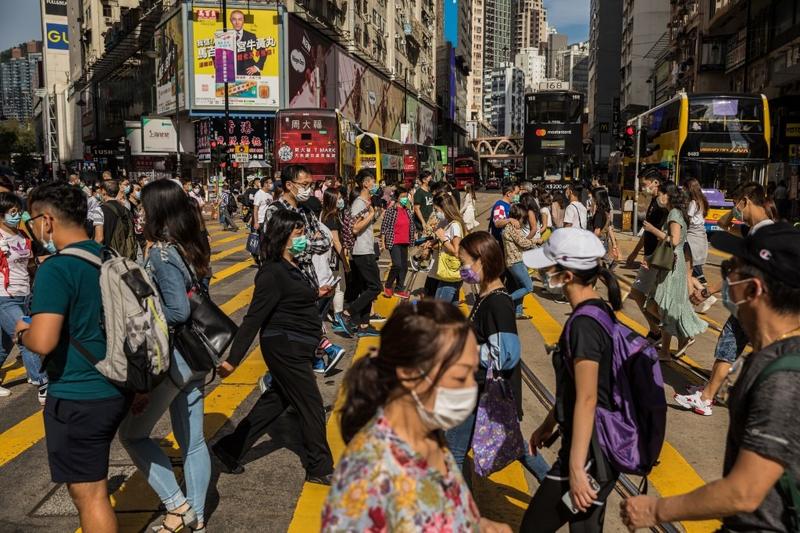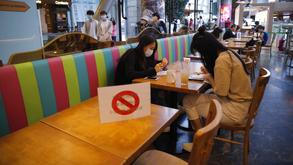Experts credit government policy and heightened awareness among ordinary people for keeping COVID- 19 under restraint in Hong Kong. Chen Zimo reports.
 People wearing face masks as a preventative measure against COVID-19 cross a street in the Causeway Bay shopping district in Hong Kong on May 1, 2020.
(DALE DE LA REY / AFP)
People wearing face masks as a preventative measure against COVID-19 cross a street in the Causeway Bay shopping district in Hong Kong on May 1, 2020.
(DALE DE LA REY / AFP)
Local observers are calling Hong Kong’s effort to control the COVID-19 epidemic a success, earned by a combination of government restrictions and public cooperation.
Thanks to this, life returns to some semblance of normalcy, after three grueling months of a citywide effort to control the outbreak, experts say.
Public awareness of the seriousness of the global pandemic contributed substantially to the effectiveness of the government containment measures, says Leung Chi-chiu, chairman of the Advisory Committee on Communicable Diseases under the Hong Kong Medical Association. He noted that the city escaped large-scale outbreaks that have brought other cities to their knees.
READ MORE: HK's edge over Singapore shows early social distancing works
New, confirmed cases in Hong Kong dropped significantly during the second half of April. The city has recorded zero new locally transmitted case since April 26. The seven new cases confirmed since were travelers coming from overseas.
As of May 8, among the 1,044 cases confirmed in Hong Kong, 960 had been discharged from hospitals and four had died.
On another reassuring note, there were few local infections to which the source could not be traced, Leung said.
Foreign governments should consider promoting wearing masks to make their people take the responsibility to protect themselves, said Leung Chi-chiu, chairman of the Advisory Committee on Communicable Diseases under the Hong Kong Medical Association
The trend suggests that Hong Kong has a good chance of avoiding community transmission that might have spread from a spike in imported cases in March. The alert started flashing two months ago when local government and medical experts noted a massive outbreak as tens of thousands of travelers returned from overseas, following an escalating global pandemic. Most returning travelers were in home quarantine after handing in their samples, more than 400 tested positive.
The plague has spread to more than 200 countries and regions, some faring badly. The United States has been battered with more than 1.2 million cases and over 75,000 deaths.
Governments have taken measures with varying degrees of success.
Comparing Hong Kong’s epidemic prevention efforts with those of other parts of the world, Leung noted a major difference as to whether people took prudent precautionary actions in their daily lives.
The governments may have suspended border crossings and shut down high-risk areas, like bars and gymnasiums, but they maintain essential services, like supermarkets and pharmacies, said Leung.
The Hong Kong government managed to convince its residents to practice self-protection, by wearing masks in all public spaces, compared to people in the US and European countries who refused to do so despite being encouraged by the governments. Even if people followed social distancing and kept 1.5 meters away from others, there remained the danger of contact with contaminated surfaces, said Leung.
Some people in the West chose to dismiss the pandemic or to take it lightly.
Widespread lapses by people who refused to believe self-protection diminished the effectiveness of home quarantines. “This is regrettable,” says Leung. Since the principal vehicle of transmission is respiratory droplets, he added, physical protection is considered the most effective means to prevent infections from diseases like COVID-19.
“Wearing a mask is not supposed to be something heretical,” he said. As early as 1918, during the Spanish flu, the US government made wearing masks mandatory.
Foreign governments should consider promoting wearing masks to make their people take the responsibility to protect themselves, Leung said.
 Social distancing signs are seen on tables in a restaurant in Hong Kong, March 29, 2020, amid an outbreak of the new coronavirus.
(KIN CHEUNG/AP)
Social distancing signs are seen on tables in a restaurant in Hong Kong, March 29, 2020, amid an outbreak of the new coronavirus.
(KIN CHEUNG/AP)
Focus on high-risk groups
With the public at large accepting the need for self-restriction in Hong Kong, the government was able to focus attention on groups, said Leung.
Self-quarantine also helped to prevent spreading the pandemic by carriers of the virus who tested positive but showed no symptoms
From the time the first infection was reported on January 23, the plan went into operation.
The government mapped out a plan to protect medical staff becoming overwhelmed. Virus testing was implemented at hospitals first, starting with patients complaining of respiratory problems at hospital emergency wards. Testing was expanded to chronic care wards, then outpatient facilities, and private clinics, where doctors took deep throat saliva samples and sent them to be tested.
Since January, about 160,000 people have been tested. The number is relatively small compared with the 660,000 tested in South Korea. Hong Kong, however, focused on high-risk groups, including travelers from overseas, and people in close contact with COVID-19 patients.
Self-quarantine also helped to prevent spreading the pandemic by carriers of the virus who tested positive but showed no symptoms. An asymptomatic carrier not wearing a mask would put countless others at risk of severe respiratory complications, appearing within two weeks of the initial infection. If a patient proved to be infected but asymptomatic, but wearing a mask, the number of close contacts would be limited to a few dozen.
ALSO READ: COVID-19: HK reports no new local infections for 19 days
The scale of testing and the scale of targeted groups needed to be adapted to meet unprecedented circumstances, said Leung. Had there be reports of massive community outbreak from unknown causes, it might demand widespread testing, even universal testing to lessen the risks posed by asymptomatic patients, he added.
Care homes remain clear
Hong Kong has also earned applause for avoiding mass infections in residential institutions, such as nursing homes and dormitories. These places quickly were cited as epidemic hot spots once an infection strikes.
The Department of Health have confirmed that as of May 7, no cases had been reported in about 600 nursing homes in Hong Kong
Local experts, from the very beginning, urged the Hong Kong government to pay special attention to the protection of the elderly. A study by the University of Hong Kong found that the death rate for patients over age 70 is about three times the average throughout the population. People in this age group are also three times as likely to contract the disease than the general public. In other words, people aged over 70 are up to 10 times more likely to die from COVID-19 than younger people, according to the study.
The Department of Health have confirmed that as of May 7, no cases had been reported in about 600 nursing homes in Hong Kong. There were 1.27 million people aged 65 and over in Hong Kong in 2018. Subsidized and non-subsidized nursing homes in the city provide about 75,000 beds for the elderly.
Since the outbreak, local nursing homes have suspended visits and furloughed staff who have travel histories within 14 days of returning to work. Cleaning and disinfection have been intensified. The government has provided masks and disinfectants.
For elderly people in their own home, the government has mandated viral testing for all people over the age of 65 who have returned from overseas and those who lived with the elderly before they started a 14-day home quarantine.
These prompt diagnoses and protection for the elderly have significantly reduced the mortality rate of COVID-19 in Hong Kong.
While local hospitals were under pressure during the peak of the outbreak in March, they were not as overwhelmed as those at global epicenters, said Leung.
According to Leung, at its most severe stage, about 10 patients in critical condition required respiratory support machines, which the public health system was able to provide. Meanwhile, less severely affected patients also receive sufficient care to ensure their conditions did not deteriorate.
A “new norm” with the virus
Medical experts in Hong Kong have joined their counterparts around the world to suggest that society needs to accept the existence of the virus as a “new norm”. It falls to the government and to the public to maintain a normal life while remaining vigilant against the risks of another global health crisis.
Even when the city one day has resumed all the social activities and cross-border travel, people will still need to be prepared to put on masks in the event of new cases, even a few sporadic cases, said Yuen Kwok-yung, a top microbiologist from the University of Hong Kong at a recent television interview. He is now an adviser to the Hong Kong government.
Medical experts in Hong Kong have joined their counterparts around the world to suggest that society needs to accept the existence of the virus as a “new norm”
He said another outbreak cannot be ruled out, and the situation can be even more disastrous if people are not prepared. He cited a study conducted three months ago on 500 Hong Kong people. The study found no signs of antibodies, meaning most Hong Kong people were not immune to the virus, he concluded.
David Hui Shu-cheong, an infectious disease expert at the Chinese University of Hong Kong, expected it would take a year to a year and a half, at the earliest, to produce a vaccine for the novel coronavirus. Until then, members of the public should keep wearing face masks and observe good personal hygiene.
On Friday, Hong Kong eased some social distancing rules as cinemas, bars and beauty parlors reopened. Schools will reopen in phases starting from May 27.
The government has announced plans to distribute reusable and disposable face masks for free to the residents, and estimated there will be enough supply of masks for this year.
Leung expressed optimism that if the public could maintain self-restraint and stay vigilant after the government lifts enforcement measures, Hong Kong would be able to mount an effective response if there were a third or fourth wave of infections brought by travelers from overseas.


